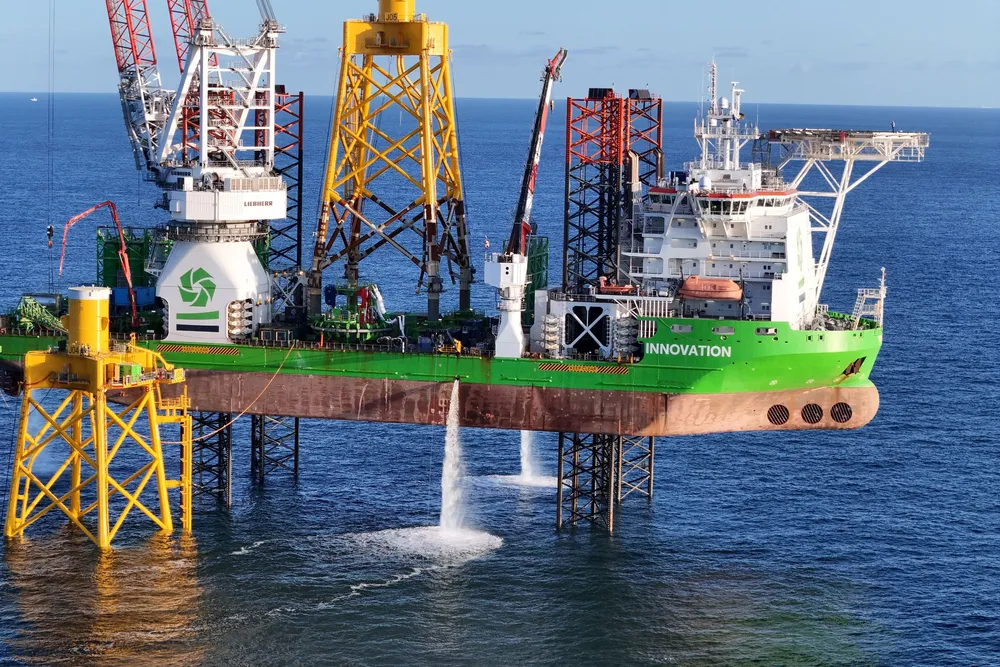Ocean Winds starts work on next project as French political crisis casts a shadow
Ocean Winds is involved in three construction projects as industry braces for political turbulence

Ocean Winds started installing a first jacket foundation on another French offshore wind farm this week — meaning the Engie-EDP Renewables joint venture is currently engaged in three active construction projects there — but political events in Paris are also a cause for concern as the company prepares to bid for more acreage.
Installation of a first turbine foundation began this week on the 496MW Dieppe-Le Treport (EMDT) offshore wind farm in northern France, where Ocean Winds is partnered by Sumitomo and Banque des Territoires.
The offshore substation for this wind farm was installed in June, using a steel jacket supplied by Navantia in Spain.
The company will start installing 8MW turbines next year, using Cherbourg as the marshalling port, and aims to finish commissioning turbines for the project before the end of next year.
Final phase
The start of the main offshore construction campaign on EMDT comes just as Ocean Winds moves into the home straight on construction of the 496MW Yeu and Noirmoutier islands (EMYM) project, in northwestern France.
Unlike EMDT, the EMYN project uses monopile foundations.
Both projects originally specified jackets, but a strengthening economic case for a monopile solution resulted in the decision to apply for this technical change on both projects, Hirt told reporters during a press trip to the EMYN wind farm.
Hirt explained that the process of amending permits opens up a channel for legal challenges, and this carries the risk of creating delays.
Fishing interests and opposition to the wind farm was stronger in the Dieppe-Le Treport region, leading to differing outcomes.
“Here in Ile de Noirmoutier we enjoy strong support for the project and it was possible to get the change done without risking any delays. That was not the case at Dieppe-Le Treport ” he said.
Turning point?
These two projects are contributing to what may be a turning point for offshore wind in France.
A first wave of projects dating back to 2012 and 2013 tenders suffered heavy delays due to a mix of permitting issues, legal challenges and a government decision to renegotiate tariffs in 2018.
Meanwhile, France has revamped its permitting process, mapped out ambitions of awarding nearly 2GW of offshore wind capacity per year and launched of a new spatial plan with priority areas for offshore wind development.
Ocean Winds has more than its fair share of involvement in a growing pipeline of newer projects.
It is in the early stage of development of Eoliennes Flottantes d’Occitanie (EFLO), a 250MW floating project awarded its offtake and grid connection package in late 2024.
Ocean Winds is also involved in the ongoing AO9 offshore wind tender process. This tender offers advantages in terms of logistics and connections though extensions to existing offshore wind developments.
Hirt said Ocean Winds is keen on building on such synergies, albeit subject to the rule that limits bidders to the award of only one extension area per round.
Ocean Winds is pursuing the area known as Narbonnaise 2, which is an extension from the company’s own EFLO project in the Occitanie region, but Hirt added that this did not exclude the possibility of bidding for the other two extension areas included in AO9.
There are, respectively, the Gulf of Fos 2 which is an extension of the 250MW floating wind area awarded to EDF Renewables and Maple Power last year, and South Brittany 2, which is an extension of the 250MW area awarded to Elicio and BayWa r.e.
AO9 in trouble?
But concern is also growing that publication of the enabling regulations that are required to stage AO9 is starting to run late.
“The regulations were supposed to be issued at the end of the summer, and that is where we are now,” Hirt noted.
Like other developers with an interest in AO9 and other future offshore wind opportunities, Hirt admitted to some concern about the political instability currently facing France.
“Getting the message across about the importance of the energy transition is more important than ever now that politics has become more volatile,” Hirt said.
But publication of the regulations has been overtaken by the vote of confidence that the administration of Prime Minister François Bayrou is facing in the National Assembly.
Hirt nevertheless expressed optimism that the system will continue to function even if a government falls and the country faces a period of uncertainty.
Bidding is supposed to take place four months after publication of the detailed tender rules, so AO9 already looks unlikely to reach its conclusion in 2025, as was intended.
However, there is also evidence that the regulations are ready to be published imminently.
AO9 was originally expected to include the Oberon 2 extension area, but this was withdrawn.
(Copyright)